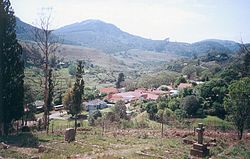Pilgrim's Rest, Mpumalanga
|
Pilgrim's Rest Pelgrimsrus |
|
|---|---|

Pilgrim's Rest in 1998
|
|
|
|
|
| Coordinates: 24°54′28″S 30°45′24″E / 24.90778°S 30.75667°ECoordinates: 24°54′28″S 30°45′24″E / 24.90778°S 30.75667°E | |
| Country | South Africa |
| Province | Mpumalanga |
| District | Ehlanzeni |
| Municipality | Thaba Chweu |
| Area | |
| • Total | 25.40 km2 (9.81 sq mi) |
| Population (2011) | |
| • Total | 1,721 |
| • Density | 68/km2 (180/sq mi) |
| Racial makeup (2011) | |
| • Black African | 93.4% |
| • Coloured | 1.5% |
| • White | 4.8% |
| • Other | 0.3% |
| First languages (2011) | |
| • Northern Sotho | 50.4% |
| • Sotho | 15.3% |
| • Swazi | 13.5% |
| • Tsonga | 5.9% |
| • Other | 14.8% |
| PO box | 1290 |
| Area code | 013 |
Pilgrim’s Rest (Afrikaans: Pelgrimsrus) is a small town in the Mpumalanga province of South Africa which is protected as a provincial heritage site. It was the second of the Transvaal gold fields, attracting a rush of prospectors in 1873, soon after the MacMac diggings started some 5 kilometres (3.1 mi) away. Alluvial panning eventually gave way to deeper ore mining. In the 1970s the town, not greatly changed, became a tourist destination.
The alluvial gold was discovered by prospector Alec Patterson. He panned Pilgrim's Creek, as it became known, when the nearby MacMac diggings became too crowded. He kept his find a secret, but a gold rush resulted when fellow prospector William Trafford registered his claim with the Gold Commissioner at MacMac. After it was officially declared a gold field in September 1873, the town suddenly grew to 1,500 inhabitants searching for alluvial gold.
In the 1880s the alluvial gold dwindled and prospectors were attracted to Barberton's newly discovered gold deposits. Towards the end of the 19th century claims were bought up and underground mining started by the company known as TGME. The better-funded mining companies started mining the deeper gold-bearing ore. By 1895 several small mining companies amalgamated to form the Transvaal Gold Mining Estates (T.G.M.E.).
As the volumes of gold ore increased, the engineers constructed small, local hydro-electric plants to generate electricity for the electric tramway and the ore crushers at the reduction works, built in 1897. In 1911 the 2,000 kW Belvedere power station (at 24°39′18″S 30°50′12″E / 24.65500°S 30.83667°E) was completed on the Blyde River, some 30 km to the east. It supplied hydro-electric power to Pilgrim's Rest and adjacent communities up to 1992. Pilgrim's Rest was southern Africa's second town with street electricity, the first being Kimberley, also a mining town.
...
Wikipedia



